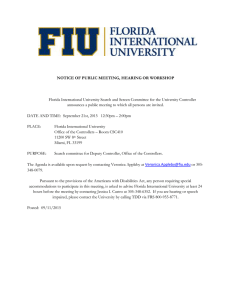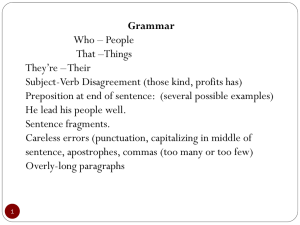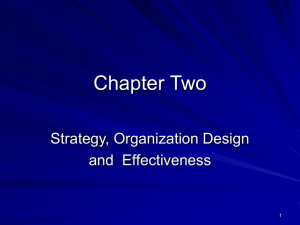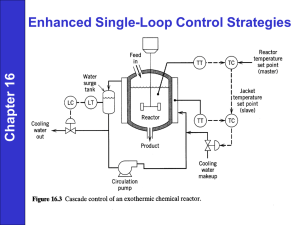Coarticulation in Markov Decision Processes Khashayar Rohanimanesh Robert Platt Sridhar Mahadevan
advertisement
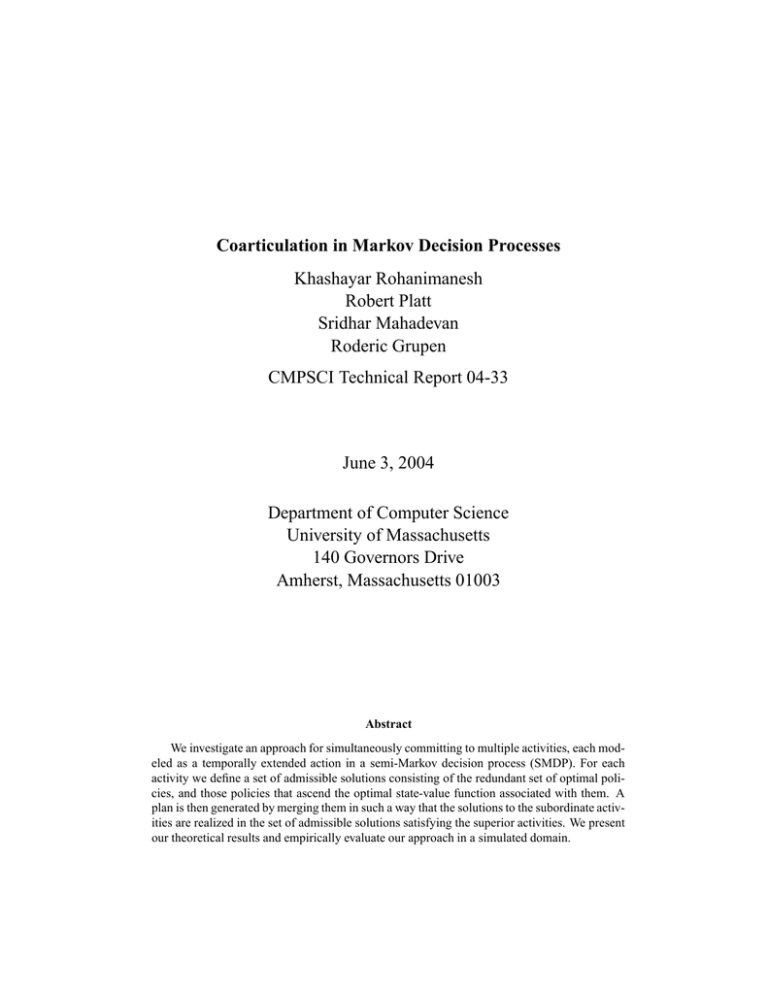
Coarticulation in Markov Decision Processes
Khashayar Rohanimanesh
Robert Platt
Sridhar Mahadevan
Roderic Grupen
CMPSCI Technical Report 04-33
June 3, 2004
Department of Computer Science
University of Massachusetts
140 Governors Drive
Amherst, Massachusetts 01003
Abstract
We investigate an approach for simultaneously committing to multiple activities, each modeled as a temporally extended action in a semi-Markov decision process (SMDP). For each
activity we define a set of admissible solutions consisting of the redundant set of optimal policies, and those policies that ascend the optimal state-value function associated with them. A
plan is then generated by merging them in such a way that the solutions to the subordinate activities are realized in the set of admissible solutions satisfying the superior activities. We present
our theoretical results and empirically evaluate our approach in a simulated domain.
1 Introduction
Many real-world planning problems involve concurrent optimization of a set of prioritized subgoals of the problem by dynamically merging a set of (previously learned) policies optimizing the
subgoals. A familiar example of this type of problem would be a driving task which may involve
subgoals such as safely navigating the car, talking on the cell phone, and drinking coffee, with the
first subgoal taking precedence over the others. In general this is a challenging problem, since activities often have conflicting objectives and compete for limited amount of resources in the system.
We refer to the behavior of an agent that simultaneously commits to multiple objectives as Coarticulation, inspired by the coarticulation phenomenon in speech. In this paper we investigate a
framework based on semi-Markov decision processes (SMDPs) for studying this problem. We assume that the agent has access to a set of learned activities modeled by a set of SMDP controllers
each achieving a subgoal
from a set of subgoals
.
We further assume that the agent-environment interaction is an episodic task where at the beginning of each episode a subset of subgoals
are introduced to the agent, where subgoals are
ranked according to some priority ranking system. The agent is to devise a global policy by merging the policies associated with the controllers into a global policy that simultaneously commits to
them according to their degree of significance. In general optimal policies of controllers do not
offer flexibility required for the merging process. Thus for every controller we also compute a set
of admissible suboptimal policies that reflect the degree of flexibility we can afford in it. Given a
controller, an admissible policy is either an optimal policy, or it is a policy that ascends the optimal state-value function associated with the controller (i.e., in average leads to states with higher
values), and is not too off from the optimal policy.
C1
C
d
c b
a
a
b
c
S
S
(a)
C2
!
(b)
"
Figure 1: (a) actions , , and are ascending on the state-value function associated with the controller , while action is descending; (b) action and ascend the state-value function
and
respectively, while they descend on the state-value function of the other controller. However action
ascends the state-value function of both controllers (the dotted line shows a trajectory that achieves
both subgoals while ascending both value functions).
2
To illustrate this idea, consider Figure 1(a) that shows a two dimensional state-value function.
Regions with darker colors represents states with higher values. Assume that the agent is currently
in state marked . The arrows show the direction of state transition as a result of executing different
actions, namely actions , , , and . The first three actions lead the agent to states with higher
values, in other words they ascend the state-value function, while action descends it. Figure 1(b)
shows how introducing admissible policies enables simultaneously solving multiple subgoals. In
this figure, action and are optimal in controllers
and
respectively, but they both descend
the state-value function of the other controller. However if we allow actions such as action , we are
guaranteed to ascend both value functions, with a slight degeneracy in optimality. The dotted line
in this figure shows a trajectory that achieves both subgoals while ascending both value functions.
Most of the related work in the context of MDPs assume that the subprocesses modeling the activities are additive utility independent (Boutilier et al., 1997; Guestrin and Gordon, 2002) and do not
address concurrent planning with temporal activities. In contrast we focus on problems that involve
temporal abstraction where the overall utility function may be expressed as a non-linear function
of sub-utility functions that have different priorities. Our approach is also similar in spirit to the
redundancy utilization formalism in robotics (Nakamura, 1991; Huber, 2000; Platt et al., 2002), and
in motor coordination (also know as the “uncontrolled manifold”) (Pellionisz and Llinas, 1985).
Huber et al. (1996) propose using a small set of pre-defined closed-loop controllers (a control basis)
to generate a wide variety of robot behavior. By executing closed-loop controllers concurrently in a
prioritized relationship, the robot can realize a more efficient policy. In addition, because one controller always has top priority, it is possible to guarantee that the system obeys a set of pre-defined
constraints. Most of these ideas, however, have been investigated in continuous domains and have
not been extended to discrete domains. In contrast we focus on discrete domains modeled as MDPs.
In this paper we formally introduce the framework of redundant controllers in terms of the set of
admissible policies associated with them and present an algorithm for merging such policies given
a coarticulation task. We also present a set of theoretical results analyzing various properties of
such controllers, and also the performance of the policy merging algorithm. The theoretical results
are complemented by an experimental study that illustrates the trade-offs between the degree of
flexibility of controllers and the performance of the policy generated by the merging process.
!
!
2 Redundant Controllers
In this section we introduce the framework of redundant controllers and formally define the set
of admissible policies in them. For modeling controllers, we use the concept of subgoal options
(Precup, 2000). A subgoal option can be viewed as a closed loop controller that achieves a subis defined by a tuple
goal of some kind. Formally, a subgoal option of an MDP
. The MDP
is the option MDP (Ravindran, 2003) induced
by the option in which
,
,
is the transition probability function induced by ,
and
is chosen to reflect the subgoal of the option. The policy component of such options are the
solutions to the option MDP
associated with them. For generality, throughout this paper we
refer to subgoal options simply as controllers.
For theoretical reasons, in this paper we assume that each controller optimizes a minimum cost-
3
to-goal problem. An MDP
modeling a minimum cost-to-goal problem includes a set of goal
. We also represent the set of non-goal states by
. Every action in a
states
non-goal state incurs some negative reward and the agent receives a reward of zero in goal states. A
controller is a minimum cost-to-goal controller, if
optimizes a minimum cost-to-goal problem. The controller also terminates with probability one in every goal state. We are now ready to
formally introduce the concept of ascending policies in an MDP:
Definition 1: Given an MDP
!% "$#&%('
- , a function . /0!% "+#&%(' , and a deterministic
) +*,
. , where
policy , let is the expectation
with respect to the distribution over next states given the current state and the policy . Then is ascending on , if for every state (except for the goal states if the MDP models a minimum
cost-to-goal problem) we have 2143 .
46 -7
For an ascending policy on a function , function 5
gives a strictly positive value
that measures how much the policy ascends on in state . A deterministic policy is descending
on , if for some state , 8 :9;3 . In general we would like to study how a given policy behaves
with respect to the optimal value function in a problem. Thus we choose the function to be the
optimal state value function (i.e., <= ). The above condition can be interpreted as follows: we are
interested in policies that in average lead to states with higher values, or in other words ascend the
state-value function surface. Note that Definition 1 extends the Lyapunov functions introduced in
(Perkins and Barto, 2001) to the case of non-deterministic MDPs. The minimum and maximum rate
at which an ascending policy in average ascends < = are given by:
Definition 2: Assume that the policy is ascending on the optimal state value function < = .
, ACBD>E1F3 .
Then ascends on < = with a factor at least > , if for all non-goal statesONQ
JILK,M @?RP S
We also define the guaranteed expected ascend rate of as: GH
. The maximum
UILVAW ON R P S
possible achievable expected ascend rate of is also given by T .
One problem with ascending policies is that Definition 1 ignores the immediate reward which
the agent receives. For example it could be the case that as a result of executing an ascending policy,
the agent transitions to some state with a higher value, but receives a huge negative reward. This
can be counterbalanced by adding a second condition that keeps the ascending policies close to the
optimal policy:
Definition 3: Given a minimum cost-to-goal problem modeled by an MDP
,
a deterministic policy is X -ascending on
if: (1) is ascending on < = , and (2) X is the maximum
+Z\[
value in the interval Y3
such that ] ^?
we have _ = ` a:B b < = A .
Here, X measures how close the ascending policy is to the optimal policy. For any X , the second
[
_.=d ` Aae?gf b <:=d A <:=d A (note that because
models a
condition assures that: ] c?
minimum cost-to-goal problem, all values are negative). Naturally we often prefer policies that are
Z
X -ascending for X values close to . In section 3 we derive a lower bound on X such that no policy
4
for values smaller than this bound is ascending on < = (in other words X cannot be arbitrarily small).
.
Similarly, a deterministic policy is called X -ascending on , if is X -ascending on
Note that in general by allowing admissible policies, we have extended the set of acceptable
solutions from the set of optimal policies to a possibly larger set of solutions including the set of
admissible policies. Next, we introduce the framework of redundant controllers:
Definition 4: A minimum cost-to-goal controller is an X -redundant controller if there exist
multiple deterministic policies that are either optimal, or X -ascending on . We represent theN set of
b
UI K,M G ,
such admissible policies by . Also, the minimum ascend rate of is defined as: G
b
where G is the ascend rate of a policy ? (see Definition 2).
We can compute the X -redundant set of policies for a controller as follows. Using the reward
model, state transition model, < = and _ = , in every state ? , we compute the set of actions that
b
b
are X -ascending on represented by
?
` c?
, that satisfy both conditions of Definition 2.
Next, we present an algorithm for merging policies associated with a set of prioritized redundant
controllers that run in parallel. For specifying the order of priority relation among the controllers
, where the relation “ ” expresses the subject-to relation (taken from
we use the expression
(Huber, 2000)). This equation should read: controller subject-to controller . A priority ranking
system is then specified by a set of relations
. Without loss of generality we assume that
9 . Algorithm
the controllers are prioritized based on the following ranking system:
MergeController summarizes the policy merging process. In this algorithm, represents the
Algorithm 1 Function MergeController(s,
)
b
1: Input: current state ; the set of controllers ; the redundant-sets
O for every controller
.
b
2: Initialize: A
+ .
!
perform:
3: For
b
ILVAW
/.
#" ?$&%(' *) ;
?
49
where +Q such that A-,
Z JZ
(initially Q
).
+ 4: Return an action 5?01%(' 7 ) A .
b32
Z54
4
2 up to the controller (i.e.,
ordered intersection of the redundant-sets
) constrained
by the order of priority. In other words, each set O contains a set of actions in state that are all
X -ascending with respect to the superior controllers
.
Due to the limited amount of redundancy in the system, it is possible that the system may not be
able to commit to some of the subordinate controllers.
This happens when none of the actions
b62
2 ) are X -ascending with respect to the supewith respect to some controller
(i.e., F?
rior controllers. In this case the algorithm skips the controller , and continues the search in the
redundant-sets of the remaining subordinate controllers.
The complexity of
the
b the above algorithm consists of the following costs: (1) cost of computing
8 9:
for a controller which is linear in the number of states and actions: 7 redundant-sets
,
5
-Z 0
(2) cost of performing Algorithm MergeController in every state , which is 7 a
, where
is the number of subgoals. In the next section, we theoretically analyze redundant controllers and
the performance of the policy merging algorithm in various situations.
3 Theoretical Results
In this section we present some of our theoretical results characterizing X -redundant controllers, in
terms of the bounds on the number of time steps it takes for a controller to complete its task, and the
performance of the policy merging algorithm. For lack of space, we have abbreviated the proofs.
In section 2 we stated that there is a lower bound on X such that there exist no X -ascending policy for
values smaller than this bound. In the first theorem we compute this lower bound:
Theorem 1 Let
policy defined on
UILVAW ON R P S
< =
be a minimum cost-to-goal MDP and let < =
. Then
A .
X is bounded by X;1
< =
, where
be an X -ascending
ILK,M O N R P S
<:= A and
!% "$# %(' < = * < = 1 3 ,
is an X -ascending policy, we have ] ?
4
and _ = ` a2B b < = A . By rearranging the terms in the latter, first we obtain X_ = ` a
!% "+#&%(' X_ = ` Aa 13 . Thus:
<:= A . Then we substitute it for < =d to obtain
<:= $* N
N
/
' ) ' )
R < =
R < = * B
X 1
_ = ` a < = (1)
/ N
' )
<2= R <:= < = < = Proof: Since
4
<2
=
9 3 , and
note that since
models a minimum cost-to-goal problem, we have <)=
. Such a lower bound characterizes the maximum flexibility we can afford in
< =
B < =
a redundant controller and gives us an insight on the range of X values that we can choose for it.
In the second theorem we derive an upper bound on the expected number of steps that a minimum
cost-to-goal controller takes to complete when executing an X -ascending policy. We first present the
following lemma:
Lemma 1: Let be a minimum cost-to-goal controller and let
be an X -ascending policy on .
Then for any non-goal state , there exists a state * , such that 13 and < = * 1< = .
Let be the set of states
/ Nlemma
Proof: We prove the
' ) by contradiction.
Z
1 3 (note that ) and assume that ] *^? <:=d +*,e9
6
* ?
such that
<2= . Also let
ILVAW
/ N
this gives < = * . Then we have:
U. !% "+#&%(' < = * N ' ) < = * ' ) 4
<
,N / N ' ) <
A
4
< = < = = = (2)
< = 4
3
3 which contradicts the fact that is an X -ascending policy on .
Theorem 2 Let be an X -ascending minimum cost-to-goal controller and let denote the cur
rent state of the controller. Then any X -ascending policy on will terminate the controller in some
"' )
goal state with probability one. Furthermore, termination occurs in average in at most
steps, where G is the guaranteed expected ascend rate of the policy .
Proof (sketch): Since terminates only
in goal states, we only need to show there exists a goal
such that
13 , where
is the multi-step transition probability (Precup, 2000)
state ^?
until it terminates in state * . Based on Lemma 1,
that gives the probability of executing in state
13 , and the sequence < =d <2=d <:=d there exists a path
such that
is monotonically increasing. Thus in the limit < = and
< = for some goal state
thus we have 13 . Note that at every
step the value of a state increases by GH in average, thus
"' )
in average it will take at most
steps for
in the sequence
to converge to
some goal state .
This result assures that the controller arrives in a goal state and will achieve its goal in a bounded
number of steps. We use this result when studying performance of running multiple redundant controllers in parallel. Next, we study how concurrent execution of two controllers using Algorithm
MergeController impacts each controller (this result can be trivially extended to the case when a set
of
1 controllers are executed concurrently):
, and any two minimum cost-to-goal redundant
Theorem 3 Given an MDP
controllers
defined over , the policy obtained by Algorithm MergeController
b
b based on
.
, ,
the ranking system
is X -ascending on A . Moreover, if ] ^?
UILK M
policy will be ascending on both controllers with the ascend rate at least G G G .
This theorem states that merging policies of two controllers using Algorithm MergeController
would generate a policy that remains X -ascending on the superior controller. In other words it
does not negatively impact the superior controller.
Proof b(sketch):
Since
, Algorithm MergeController will always select an action from
. Thus the resulting policy remains X -ascending on . When we have ] D?
the set
7
b b , . , then the policy generated by Algorithm MergeController is X -ascending
and X -ascending with respect to the controller , and thus it aswith respect to the controller
I K,M cends both < = and < = A with an ascend rate at least
G G .
In the next theorem, we establish bounds on the expected number of steps that it takes for
the policy obtained by Algorithm MergeController to achieve a set of prioritized subgoals
by concurrently executing the associated controllers
:
Theorem
Z 4 Assume
) controllers defined over MDP
is a set of minimum cost-to-goal X -redundant
(
. Let the policy denote the policy obtained
by Algorithm MergeController based on the ranking system
9 . Let denote the
expected number of steps for the policy for achieving all the subgoals
associated with the set of controllers, assuming that the current state of the system is . Then the following
expression holds:
1(03245 !
)(*,+ 7 6 .-0/
$" #%'&
(3)
where T is the maximum possible achievable expected ascend rate for the controller (see Defi:9 :9
:9 9
nition 2), is the set of sequences 8
is a goal state in controller
in which
9
=< 3>
3? over sequences 8 ? (i.e.,
?
). The probability distribution ;8 gives the probability of executing the set of controllers in sequence based on the order of priority
9
:9 starting in state , and observing the goal state sequence
.
Proof (sketch): Based on Theorem 3, when
Algorithm
MergeController always finds a policy b
.
, ), policy will ascend on all controllers.
that optimizes all controllers (i.e., ] ^?
@>
Thus in average the total time for all controllers to terminate equals the time required
for a controller
' )
I VAW
"
that takes the most time to complete which has the lower bound of
A ' ) . The worst case
happens when the policy generated by Algorithm MergeController can not optimize more than
one controller at a time. In this case always optimizes the controller with the highest priority until
its termination, then optimizes the second highest priority controller and continues this process to
the end in a sequential manner. The right hand side of the inequality given by Equation 3 gives an
upper bound for the expected time required for all controllers to complete when they are executed
sequentially. The above theorem implicitly states that when Algorithm MergeController generates
a policy that in average commits to more than one subgoal it potentially takes less number of steps
to achieve all the subgoals, compared to a policy that sequentially achieves them according to their
degree of significance.
4 Experiments
In this section we present our experimental results analyzing redundant controllers and the policy
Z
Z
merging algorithm described in section 2. Figure 2(a) shows a 3B 3 grid world where an agent is
ED
C (in this example
to visit a set of prioritized locations marked by C
). The agent’s
8
goal is to achieve all of the subgoals by focusing on superior subgoals and coarticulating with the
subordinate ones. Intuitively, when the agent is navigating to some subgoal C of higher priority, if
some subgoal of lower priority C is en route to C , or not too off from the optimal path to C , the
agent may choose to visit C .
We model this problem by an MDP
, where is the set of states consisting
Z
of 3d3 locations in the room, and is the set of actions consisting of eight stochastic navigation
actions (four actions in the compass direction, and four diagonal actions). Each action moves the
Z.
agent in the corresponding direction with probability and fails with probability H (in all of
3 ). Upon failure the agent is randomly placed in
the experiments we used success probability
one of the eight-neighboring locations with equal probability. If a movement would take the agent
^Z
into a wall, then the agent will remain in the same location. The agent also receives a reward of
for every action executed.
We assume that the gent has access to a set of controllers
, associated with the set of
C . A controller is a minimum cost-to-goal subgoal option
subgoal locations C
, where
, the initiation set includes any locations except for the subgoal
location, and forces the option to terminate only in the subgoal location. Figures 2(b)-(d) show
examples of admissible policies for subgoal C : Figure 2(b) shows the optimal policy of the con(navigating the agent to the location C ). Figures 2(c) and 2(d) show the X -redundant
troller
3
3 3 respectively. Note that by reducing X , we obtain a larger set of
policies for X
and X
admissible policies although less optimal.
We use two different planning methods: (1) sequential planning, where we achieve the subgoals
sequentially by executing the controllers one at a time according to the order of priority of subgoals,
(2) concurrent planning, where we use Algorithm MergeController for merging the policies associated with the controllers. In the first set of experiments, we fix the number of subgoals. At the
beginning of each episode the agent is placed in a random location, and a fixed number of subgoals
D
(in our experiments
) are randomly selected. Next, the set of admissible policies (using
X
3 ) for every subgoal is computed. Figure 3 shows the performance of both planning methods, for every starting location in terms of number of steps for completing the overall task. The
concurrent planning method consistently outperforms the sequential planning in all starting locations. Next, for the same task, we measure how the performance of the concurrent method varies
by varying X , when computing the set of X -ascending policies for every subgoal. Figure 4 shows the
performance of the concurrent method and Figure 5 shows the average number of subgoals coartic
ulated by the agent – averaged over all states – for different values of X . We varied X from 3
to
Z
3 using 3 3 intervals. All ofZ these results are also averaged over 100 episodes, each consisting
of 10 trials. Note that for X
, the only admissible policy is the optimal policy and thus it does
not offer much flexibility with respect to the other subgoals. This can be also seen in Figure 5 in
Z
which the policy generated by the merging algorithm for X
3 has the minimum commitment
to the other subgoals. As we reduce X , we obtain a larger set of admissible policies, thus we observe improvement in the performance. However, the more we reduce X , the less optimal admissible
policies we obtain. Thus the performance degrades (here we can observe it for the values below
X
3 ). Figure 5 also shows by relaxing optimality (reducing X ), the policy generated by the
merging algorithm commits to more subgoals simultaneously.
9
In the final set of experiments, we fixed X to 3
and varied the number of subgoals from
3 (all of these results are averaged over 100 episodes, each consisting of 10 trials). Figto
ure 6 shows the performance of both planning methods. It can be observed that the concurrent
method consistently outperforms the sequential method by increasing the number of subgoals (top
curve shows the performance of the sequential method and bottom curve shows that of concurrent
method). Figure 7 shows the difference between the two plots in the Figure 6 which demonstrates
by increasing the number of subgoals, the performance of the concurrent method improves over the
sequential method. This is because when there are many subgoals, the concurrent planning method
is able to visit multiple subgoals of lower priority en route the primary subgoals, thus it can save
more time. This result is confirmed by Figure 8 which shows by increasing the number of subgoals
introduced in the problem, the average number of subgoals coarticulated by the concurrent method
also increases.
5 Concluding Remarks
There are a number of questions and open issues that remain to be addressed and many interesting
directions in which this work can be extended. In many problems, the strict order of priority of
subtasks may be violated: in some situations we may want to be sub-optimal with respect to the
superior subtasks in order to improve the overall performance. One other interesting direction is to
study situations when actions are structured. We are currently investigating compact representation
of the set of admissible policies by exploiting the structure of actions.
Another interesting direction is to investigate non-value based reinforcement learning methods
such as policy search methods (Baxter and Bartlett, 2000) for computing X -ascending policies in
MDPs.
Acknowledgements
This research is supported in part by a grant from the National Science Foundation #ECS-0218125.
References
Baxter, J. and Bartlett, P. (2000). Reinforcement learning in pomdp’s via direct gradient ascent. In
ICML.
Boutilier, C., Brafman, R., and Geib, C. (1997). Prioritized goal decomposition of Markov decision
processes: Towards a synthesis of classical and decision theoretic planning. In Pollack, M., editor, Proceedings of the Fifteenth International Joint Conference on Artificial Intelligence, pages
1156–1163, San Francisco. Morgan Kaufmann.
Guestrin, C. and Gordon, G. (2002). Distributed planning in hierarchical factored mdps. In In the
Proceedings of the Eighteenth Conference on Uncertainty in Artificial Intelligence, pages 197 –
206, Edmonton, Canada.
10
Huber, M. (2000). A Hybrid Architecture for Adaptive Robot Control. PhD thesis, University of
Massachusetts, Amherst.
Huber, M., MacDonald, W., and Grupen, R. (1996). A control basis for multilegged walking.
Nakamura, Y. (1991). Advanced robotics: redundancy and optimization. Addison-Wesley Pub. Co.
Pellionisz, A. and Llinas, R. (1985). Tensor network theory of the metaorganization of functional
geometries in the central nervous system. Neuroscience, 16, No. 2:245–273.
Perkins, T. J. and Barto, A. G. (2001). Lyapunov-constrained action sets for reinforcement learning.
In Proc. 18th International Conf. on Machine Learning, pages 409–416. Morgan Kaufmann, San
Francisco, CA.
Platt, R., Fagg, A., and Grupen, R. (2002). Nullspace composition of control laws for grasping.
In the Proceedings of the IEEE/RSJ International Conference on Intelligent Robots and Systems
(IROS).
Precup, D. (2000). Temporal Abstraction in Reinforcement Learning. PhD thesis, Department of
Computer Science, University of Massachusetts, Amherst.
Ravindran, B. (2003). An Algebraic Approach to Abstraction in Reinforcement Learning. PhD
thesis, Department of Computer Science, University of Massachusetts, Amherst.
11
G1
G1
G3
G4
G2
Agent
(a)
(b)
G1
G1
(c)
Z
(d)
Z
Figure 2: (a) A 3,B 3 grid world where an agent is to visit a set of prioritized subgoal locations;
3
(b) The optimal policy associated with the subgoal C ; (c) The X -ascending policy for X
; (d)
The X -ascending policy for X
3 3.
12
30
Concurrent
Sequential
Average (steps)
28
26
24
22
20
18
16
0
20
40
60
80
100
State
Figure 3: Performance of both planning methods in terms of the average number of steps in every
starting state (fixed number of subgoals (m=4)).
13
30
Concurrent
Sequential
Average (steps)
28
26
24
22
20
18
0.55 0.6 0.65 0.7 0.75 0.8 0.85 0.9 0.95
Epsilon
1
1.05
Figure 4: (Performance of the concurrent method for different values of X (fixed number of subgoals
(m=4)).
14
Number of subgoals committed
1.5
Concurrent
1.45
1.4
1.35
1.3
1.25
1.2
1.15
1.1
1.05
1
0.55 0.6 0.65 0.7 0.75 0.8 0.85 0.9 0.95
Epsilon
1
Figure 5: Average number of subgoals coarticulated using the concurrent planning method for different values of X (fixed number of subgoals (m=4)).
15
180
Concurrent
Sequential
160
Average (steps)
140
120
100
80
60
40
20
0
0
5
10
15 20 25 30 35
Number of subgoals
40
45
50
Figure 6: Performance of the planning methods in terms of the average number of steps in every
starting state v.s. the number of subgoals.
16
10
Concurrent v.s. Sequential
Difference (steps)
8
6
4
2
0
0
10
20
30
Number of subgoals
40
50
Figure 7: The difference of performance of the planning methods v.s. the number of subgoals.
Number of subgoals committed
14
Concurrent
12
10
8
6
4
2
0
0
10
20
30
40
Number of subgoals introduced
50
Figure 8: Average number of subgoals coarticulated v.s. the total number of the subgoals.
17
